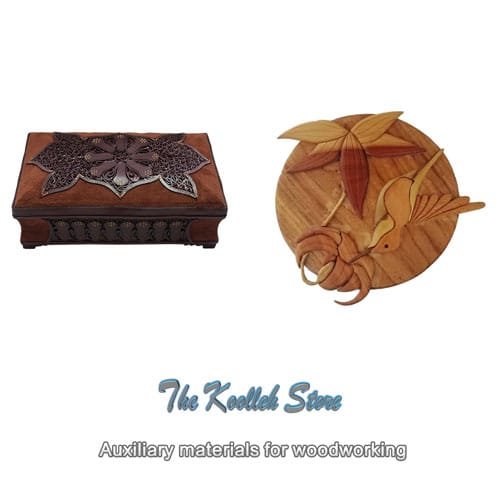Auxiliary materials for woodworking

Auxiliary materials for woodworking include the following:
1. Khatam: which is made in different colors and geometric designs. The length of the lanyard is up to 30 cm and its width is up to 2.5 cm and its diameter is up to 2 mm. For cutting Khatam, a metal hair saw on zero score is used.
2. Decorative stones: Decorative stones are used after grinding and smoothing with mosaic wood in mosaics.
3. Oysters: In mosaics, natural and artificial oysters are used.
A) Natural shellfish found along the shores of the sea and oceans are also called fish ears. The larger the size of the oyster, the better. Before use, the oysters should be peeled and smoothed.
B) Artificial oysters that are also found in the market are expensive. Some mosaics make their own shells.
The polyester is mixed with crown powder or mica powder, and some car ink ink is added to change the color. For example, silver ink is used to make silver oysters, then dryers and cobalt are added to it, and it is turned on. The surface of the flat glass, which is in a flat place and is previously surrounded by paper tape 2 to 3 mm larger than the desired material level (the thickness of the artificial shell is about 2 to 3 mm), ie a total of about 6 to 7 mm to We attach carefully and firmly so that the fluid does not flow out from under the paper tape, so that the drying of the oyster must be patient in digging and using glass. Therefore, it should be dried in a place away from direct sunlight and dust particles.
It should be noted that by changing the color of the ink, you can make oysters with the desired colors, such as red, blue, green, yellow …
Artificial oysters are better cut than natural oysters, while natural oysters are stronger and more limited in color than others, and must be soaked in lime water to bleach when used.
4. Ivory: It is a bone and ivory is used to make white, but it is less popular due to its low cost. To use ivory, they cut the cylinder in half from the middle and cut 2 to 3 mm thick layers from each half. Natural ivory is more common in India and Africa.
5. The four-handed bones and legs of camels and sometimes cows are cleaned with a solution of water and lime, and placed in water and lime for 6 months to form a completely white bone.
6. Metals: Metal sheets such as brass, copper, aluminum, etc., which have a diameter of about 2 mm, are used, which are cut with a metal saw at a score of zero.
7. White Fiber: (Ivory) found in the market and is foreign, cut and consumed with a hair saw.

